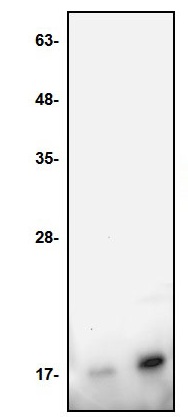BRD3-BD1 Antibody
Rabbit Polyclonal Antibody
- SPECIFICATION
- CITATIONS
- PROTOCOLS
- BACKGROUND

Application
| WB |
|---|---|
| Primary Accession | Q15059 |
| Reactivity | Human |
| Host | Rabbit |
| Clonality | Polyclonal |
| Isotype | Rabbit IgG |
| Calculated MW | 79542 Da |
| Gene ID | 8019 |
|---|---|
| Positive Control | Western Blot: Recombinant protein |
| Application & Usage | Western blot: 1-4 µg/ml. |
| Other Names | KIAA0043, RING3L |
| Target/Specificity | BRD3-BD1 |
| Antibody Form | Liquid |
| Appearance | Colorless liquid |
| Formulation | 100 µg (0.5 mg/ml) of antibody in PBS pH 7.2 containing 0.01 % BSA, 0.01 % thimerosal, and 50 % glycerol. |
| Handling | The antibody solution should be gently mixed before use. |
| Reconstitution & Storage | -20 °C |
| Background Descriptions | |
| Precautions | BRD3-BD1 Antibody is for research use only and not for use in diagnostic or therapeutic procedures. |
| Name | BRD3 {ECO:0000303|PubMed:18406326, ECO:0000312|HGNC:HGNC:1104} |
|---|---|
| Function | Chromatin reader that recognizes and binds acetylated histones, thereby controlling gene expression and remodeling chromatin structures (PubMed:18406326, PubMed:32895492, PubMed:22464331, PubMed:27105114). Recruits transcription factors and coactivators to target gene sites, and activates RNA polymerase II machinery for transcriptional elongation (PubMed:32895492, PubMed:29567837). In vitro, binds acetylated lysine residues on the N-terminus of histone H2A, H2B, H3 and H4 (PubMed:18406326). Involved in endoderm differentiation via its association with long non-coding RNA (lncRNA) DIGIT: BRD3 undergoes liquid-liquid phase separation upon binding to lncRNA DIGIT, promoting binding to histone H3 acetylated at 'Lys-18' (H3K18ac) to induce endoderm gene expression (PubMed:32895492). Also binds non-histones acetylated proteins, such as GATA1 and GATA2: regulates transcription by promoting the binding of the transcription factor GATA1 to its targets (By similarity). |
| Cellular Location | Nucleus. Chromosome. Note=Detected on chromatin |
| Tissue Location | Ubiquitous.. |

Thousands of laboratories across the world have published research that depended on the performance of antibodies from Abcepta to advance their research. Check out links to articles that cite our products in major peer-reviewed journals, organized by research category.
info@abcepta.com, and receive a free "I Love Antibodies" mug.
Provided below are standard protocols that you may find useful for product applications.
Background
The acetylation of histone lysine residues plays a crucial role in the epigenetic regulation of gene transcription. A bromodomain is a protein domain that recognizes acetylated lysine residues such as those on the N-terminal tails of histones. This recognition is often a prerequisite for protein-histone association and chromatin remodeling. These domains function in the linking of protein complexes to acetylated nucleosomes, thereby controlling chromatin structure and gene expression. Thus, bromodomains serve as “readers” of histone acetylation marks regulating the transcription of target promoters. BRD3 binds hyper-acetylated chromatin and plays a role in the regulation of transcription, probably by chromatin remodeling and interaction with transcription factors. It regulates transcription by promoting the binding of the transcription factor GATA1 to its targets and transcription of the CCND1 gene. A chromosomal aberration involving BRD3 was found in a rare, aggressive, and lethal carcinoma arising in midline organs of young people.
If you have used an Abcepta product and would like to share how it has performed, please click on the "Submit Review" button and provide the requested information. Our staff will examine and post your review and contact you if needed.
If you have any additional inquiries please email technical services at tech@abcepta.com.













 Foundational characteristics of cancer include proliferation, angiogenesis, migration, evasion of apoptosis, and cellular immortality. Find key markers for these cellular processes and antibodies to detect them.
Foundational characteristics of cancer include proliferation, angiogenesis, migration, evasion of apoptosis, and cellular immortality. Find key markers for these cellular processes and antibodies to detect them. The SUMOplot™ Analysis Program predicts and scores sumoylation sites in your protein. SUMOylation is a post-translational modification involved in various cellular processes, such as nuclear-cytosolic transport, transcriptional regulation, apoptosis, protein stability, response to stress, and progression through the cell cycle.
The SUMOplot™ Analysis Program predicts and scores sumoylation sites in your protein. SUMOylation is a post-translational modification involved in various cellular processes, such as nuclear-cytosolic transport, transcriptional regulation, apoptosis, protein stability, response to stress, and progression through the cell cycle. The Autophagy Receptor Motif Plotter predicts and scores autophagy receptor binding sites in your protein. Identifying proteins connected to this pathway is critical to understanding the role of autophagy in physiological as well as pathological processes such as development, differentiation, neurodegenerative diseases, stress, infection, and cancer.
The Autophagy Receptor Motif Plotter predicts and scores autophagy receptor binding sites in your protein. Identifying proteins connected to this pathway is critical to understanding the role of autophagy in physiological as well as pathological processes such as development, differentiation, neurodegenerative diseases, stress, infection, and cancer.


